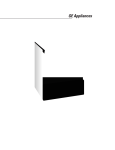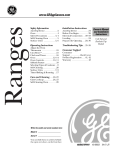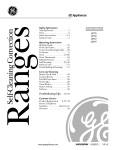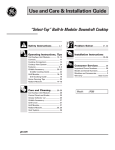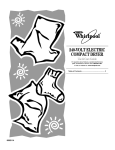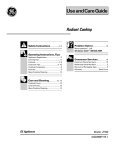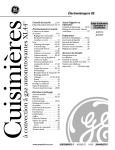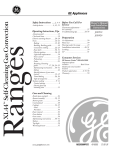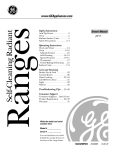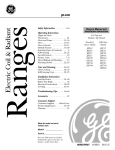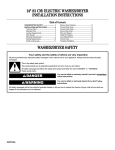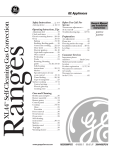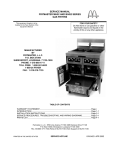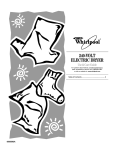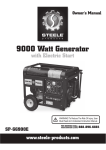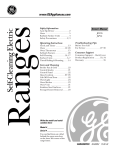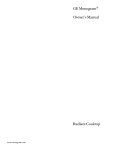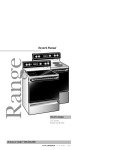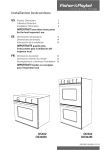Download GM JDP40 User's Manual
Transcript
Self-Cleaning Radiant Ranges GE Appliances KITCHEN TIMER ON OFF PREHEAT BAKE SELF BROIL HI/LO CLEAN UNIT ON COOKING TIME STOP TIME CLOCK CLEAR OFF UNIT ON FRONT OVEN LIGHT REAR REAR FRONT Owner’s Manual JDP40 Part No. 164D3333P207 Pub. No. 49-8980-1 318200814 Rev. B JR 12/99 Safety Instructions Operating Instructions Care and Cleaning Installation Instructions Troubleshooting Tips Customer Service Safety Information Anti-Tip Device . . . .3, 17, 22, 26 Safety Precautions . . . . . . . 3–6 Oven . . . . . . . . . . . . . . . . . . 4, 5 Radiant Surface Units . . . . . 5, 6 Operating Instructions Using the Surface Units . . . 7–9 Using the Oven . . . . . . . . 10–16 Using the Clock and Timer . . 13 Timed Baking and Roasting . 14 Oven Thermostat . . . . . . . . . 15 Self-Cleaning . . . . . . . . . . . . .16 Congratulations! You Are Now Part of the GE Family Welcome to the GE family. We’re proud of our quality products and we are committed to providing dependable service. You’ll see it in this easy-to-use Owner’s Manual and you’ll hear it in the friendly voices of our customer service department. Best of all, you’ll experience these values each time you use your range. That’s important, because your new range will be part of your family for many years. And we hope you will be part of ours for a long time to come. We thank you for buying GE. We appreciate your purchase, and hope you will continue to rely on us whenever you need quality appliances for your home. GE & You, A Service Partnership. Care and Cleaning IMPORTANT! Control Panel and Knobs . . . .17 Oven Vent . . . . . . . . . . . . . . . .17 Painted Surfaces . . . . . . . . . .17 Oven Shelves . . . . . . . . . . . . .17 Lift-Off Oven Door . . . . . . . . . 18 Oven Light Replacement . . . . 19 Broiler Pan and Grid . . . . . . . 19 Cleaning the Glass Cooktop . . 20 Fill out and return the Consumer Product Registration Card. There are two easy ways to register your appliance. ■ Through the Internet at www.geappliances.com. ■ Complete and mail the enclosed card. For Your Records Write the model and serial numbers here: # Installation Instructions # Before You Begin . . . . . . . . . 21 Preparing the Opening . . . . . 22 Electrical Connection . . . . . . 23 Install the End Cap Filler Blocks . . . . . . . . . . . . . . 24 Install the Lower Filler Trim Panel . . . . . . . . . . . . . . . . . . . 24 Install the Range . . . . . . . . . . 25 To Remove and Replace Oven Door . . . . . . . . . . . . . . . 25 Anti-Tip Bracket . . .3, 17, 22, 27 Range Retention “L” Brace . . 26 Install the Bottom Grille . . . . 27 You can find them on a label behind the range door on the front frame. Troubleshooting Tips Before You Call For Service . . . . . . . . . . . . . . 28–30 Customer Service Warranty . . . . . . . . . . . . . . . . 31 Service Telephone Numbers . . . . . . . . . . . . . . . . 32 2 Staple sales slip or cancelled check here. Proof of the original purchase date is needed to obtain service under the warranty. Read this Manual Inside you will find many helpful hints on how to use and maintain your range properly. Just a little preventive care on your part can save you a great deal of time and money over the life of your range. If You Need Service You’ll find many answers to common problems in the Before You Call For Service section. If you review our chart of Troubleshooting Tips first, you may not need to call for service at all. If you do need service, you can relax knowing help is only a phone call away. A list of toll-free customer service numbers is included in the back section of this manual. Or you can always call the GE Answer Center® at 800.626.2000, 24 hours a day, 7 days a week. Safety Instructions IMPORTANT SAFETY INFORMATION. READ ALL INSTRUCTIONS BEFORE USING. WARNING! For your safety, the information in this manual must be followed to minimize the risk of fire or explosion, electric shock, or to prevent property damage, personal injury, or loss of life. WARNING ANTI-TIP DEVICE Operating Instructions All ranges can tip and injury could result. To prevent accidental tipping of the range, secure the attached anti-tip bracket, under the rear countertop. To check if the device is installed and engaged properly, press down on the front corners of the range. Make sure it fits securely under the rear countertop. If you pull the range out from the wall for any reason, make sure the device is properly engaged when you push the range back against the wall. If it is not, there is a possible risk of the range tipping over and causing injury if you or a child stand, sit or lean on an open door. IMPORTANT SAFETY NOTICE The California Safe Drinking Water and Toxic Enforcement Act requires the Governor of California to publish a list of substances known to the state to cause cancer, birth defects or other reproductive harm, and requires businesses to warn customers of potential exposure to such substances. Installation Instructions The fiberglass insulation in self-clean ovens gives off a very small amount of carbon monoxide during the cleaning cycle. Exposure can be minimized by venting with an open window or using a ventilation fan or hood. Care and Cleaning Please refer to the Anti-Tip device information in this manual. Failure to take this precaution could result in tipping of the range and injury. SAFETY PRECAUTIONS When using electrical appliances, basic safety precautions should be followed, including the following: 3 Customer Service ■ Do not leave children alone—children should not be left alone or unattended in an area where an appliance is in use. They should never be allowed to sit or stand on any part of the appliance. ■ Do not allow anyone to climb, stand or hang on the door or cooktop. They could damage the range and even tip it over, causing severe personal injury. ■ Do not store flammable materials in an oven or near the cooktop. ■ CAUTION: Items of interest to children should not be stored in cabinets above a range—children climbing on the range to reach items could be seriously injured. Troubleshooting Tips ■ Use this appliance only for its intended purpose as described in this Owner’s Manual. ■ Be sure your appliance is properly installed and grounded by a qualified technician in accordance with the provided installation instructions. ■ Do not attempt to repair or replace any part of your range unless it is specifically recommended in this manual. All other servicing should be referred to a qualified technician. ■ Before performing any service, disconnect the range power supply at the household distribution panel by removing the fuse or switching off the circuit breaker. WARNING! SAFETY PRECAUTIONS ■ Never wear loose-fitting or hanging garments while using the appliance. Be careful when reaching for items stored over the range. Flammable material could be ignited if brought in contact with hot surface units or heating elements and may cause severe burns. ■ Use only dry pot holders—moist or damp pot holders on hot surfaces may result in burns from steam. Do not let pot holders touch hot surface units or heating elements. Do not use a towel or other bulky cloth. ■ For your safety, never use your appliance for warming or heating the room. ■ Do not let cooking grease or other flammable materials accumulate in or near the range. ■ Do not use water on grease fires. Never pick up a flaming pan. Turn the controls off. Smother a flaming pan on a surface unit by covering the pan completely with a wellfitting lid, cookie sheet or flat tray. Use a multi-purpose dry chemical or foam-type fire extinguisher. ■ Flaming grease outside a pan can be put out by covering it with baking soda or, if available, by using a multi-purpose dry chemical or foam-type fire extinguisher. Installation Instructions Care and Cleaning Operating Instructions Safety Instructions IMPORTANT SAFETY INFORMATION. READ ALL INSTRUCTIONS BEFORE USING. COOK MEAT AND POULTRY THOROUGHLY… Cook meat and poultry thoroughly—meat to at least an INTERNAL temperature of 160°F. and poultry to at least an INTERNAL temperature of 180°F. Cooking to these temperatures usually protects against foodborne illness. Troubleshooting Tips Customer Service ■ Flame in the oven can be smothered completely by closing the oven door and turning the oven off or by using a multipurpose dry chemical or foam-type fire extinguisher. ■ Use extreme caution when moving a grease kettle or disposing of hot grease. ■ Do not touch the surface units, the heating elements or the interior surface of the oven. These surfaces may be hot enough to burn even though they are dark in color. During and after use, do not touch, or let clothing or other flammable materials contact, the surface units, areas nearby the surface units or any interior area of the oven; allow sufficient time for cooling first. ■ Potentially hot surfaces include the cooktop, areas facing the cooktop, oven vent opening, surfaces near the opening, crevices around the oven door and metal trim parts above the door. ■ REMEMBER: The inside surface of the oven may be hot when the door is opened. ■ Do not store or use combustible materials, gasoline or other flammable vapors and liquids in the vicinity of this or any other appliance. ■ Keep the hood and grease filters clean to maintain good venting and to avoid grease fires. OVEN ■ Stand away from the range when opening the oven door. Hot air or steam which escapes can cause burns to hands, face and/or eyes. ■ Do not heat unopened food containers. Pressure could build up and the container could burst, causing an injury. ■ Keep the oven vent unobstructed. ■ Keep the oven free from grease buildup. ■ Place the oven shelf in the desired position while the oven is cool. If shelves must be handled when hot, do not let pot holder contact the heating elements. 4 ■ Pulling out the shelf to the stop-lock is a convenience in lifting heavy foods. It is also a precaution against burns from touching hot surfaces of the door or oven walls. ■ When using cooking or roasting bags in the oven, follow the manufacturer’s directions. ■ Do not use the oven to dry newspapers. If overheated, they can catch on fire. ■ Do not use the oven for a storage area. Items stored in an oven can ignite. ■ Do not leave paper products, cooking utensils or food in the oven when not in use. Safety Instructions SELF-CLEANING OVEN ■ Before self-cleaning the oven, remove the broiler pan, grid and other cookware. ■ Be sure to wipe up excess spillage before starting the self-cleaning operation. ■ If the self-cleaning mode malfunctions, turn the oven off and disconnect the power supply. Have it serviced by a qualified technician. Operating Instructions ■ Do not clean the door gasket. The door gasket is essential for a good seal. Care should be taken not to rub, damage or move the gasket. ■ Clean only parts listed in this Owner’s Manual. ■ Do not use oven cleaners. No commercial oven cleaner or oven liner protective coating of any kind should be used in or around any part of the oven. Residue from oven cleaners will damage the inside of the oven when the self-clean cycle is used. Use proper pan size—select cookware having flat bottoms large enough to cover the surface unit heating element. The use of undersized cookware will expose a portion of the surface unit to direct contact and may result in ignition of clothing. Proper relationship of cookware to surface unit will also improve efficiency. Customer Service 5 Troubleshooting Tips ■ Keep an eye on foods being fried at high or medium high heat settings. ■ Foods for frying should be as dry as possible. Frost on frozen foods or moisture on fresh foods can cause hot fat to bubble up and over the sides of the pan. ■ Use little fat for effective shallow or deep fat frying. Filling the pan too full of fat can cause spillovers when food is added. ■ If a combination of oils or fats will be used in frying, stir together before heating, or as fats melt slowly. ■ Always heat fat slowly, and watch as it heats. ■ Use a deep fat thermometer whenever possible to prevent overheating fat beyond the smoking point. Installation Instructions ■ Never leave the surface units unattended at high heat settings. Boilovers cause smoking and greasy spillovers that may catch on fire. ■ Only certain types of glass, glass ⁄ceramic, earthenware or other glazed containers are suitable for cooktop service; others may break because of the sudden change in temperature. ■ To minimize the possibility of burns, ignition of flammable materials and spillage, the handle of a container should be turned toward the center of the range without extending over nearby surface units. ■ Always turn the surface units off before removing cookware. ■ When preparing flaming foods under the hood, turn the fan on. Care and Cleaning RADIANT SURFACE UNITS WARNING! RADIANT SURFACE UNITS Use care when touching the cooktop. The glass surface of the cooktop will retain heat after the controls have been turned off. ■ Avoid scratching the glass cooktop. The cooktop can be scratched with items such as sharp instruments, rings or other jewelry and rivets on clothing. Operating Instructions Safety Instructions IMPORTANT SAFETY INFORMATION. READ ALL INSTRUCTIONS BEFORE USING. ■ Do not operate the radiant surface units if the glass is broken. Spillovers or cleaning solution may penetrate a broken cooktop and create a risk of electrical shock. Contact a qualified technician immediately should your glass cooktop become broken. Care and Cleaning ■ Never use the glass cooktop surface as a cutting board. ■ Do not place or store items that can melt or catch fire on the glass cooktop, even when it is not being used. Installation Instructions ■ Be careful when placing spoons or other stirring utensils on glass cooktop surface when it is in use. They may become hot and could cause burns. NOTE: We recommend that you avoid wiping any surface unit areas until they have cooled and the indicator light has gone off. Sugar spills are the exception to this. Please see Cleaning the glass cooktop section. ■ When the cooktop is cool, use only the recommended cleaning cream to clean the cooktop. ■ To avoid possible damage to the cooking surface, do not apply cleaning cream to the glass surface when it is hot. ■ After cleaning, use a dry cloth or paper towel to remove all cleaning cream residue. ■ Read and follow all instructions and warnings on the cleaning cream labels. Read and follow this Safety Information carefully. SAVE THESE INSTRUCTIONS Troubleshooting Tips Customer Service ■ Clean the cooktop with caution. If a wet sponge or cloth is used to wipe spills on a hot surface unit, be careful to avoid steam burns. Some cleaners can produce noxious fumes if applied to a hot surface. 6 Safety Instructions Using the surface units. Throughout this manual, features and appearance may vary from your model. How to Set Push the knob in and turn in either direction to the setting you want. Operating Instructions At both OFF and HI the control clicks into position. You may hear slight clicking sounds during cooking, indicating the control is keeping the power level you set. Be sure you turn the control knob to OFF when you finish cooking. Dual Surface Unit Switch To use the large (9 inch) surface unit, push in the LARGE BURNER portion of the switch. To use the small (6 inch) surface unit, push in the SMALL BURNER portion of the switch. Care and Cleaning 9" 6" The right front surface unit has 2 cooking sizes to select from so you can match the size of the unit to the size of the cookware you are using. Indicator Lights A surface unit ON indicator light will glow when any surface unit is on. NOTE: The surface unit ON indicator light may glow between the surface control settings of LO and OFF, but there is no power to the surface units. Installation Instructions A HOT SURFACE indicator light will glow as any radiant element heats up, and will remain on until the surface is cool enough to touch. Troubleshooting Tips Customer Service 7 Safety Instructions Operating Instructions Care and Cleaning About the radiant surface units… SURFACE COOKING ,,,,,,,,,,,,, ,,,,,,,,,,,, , ,,,, ,,, , ,,,,,,,,,,, , Never cook directly on the glass. Always use cookware. OFF CENTER ,,,,,,,,,,, ,,,,,,,,,,, , ,,,, ,,, ,,,,,,,,,,, , ,,,, ,,, Always place , the pan in,the center of the surface unit you are cooking on. DRAGGING , , , ,,,,,,,,,,,, , ,,,, ,,, ,,,,,,,,,,,, ,,,,,,,,,,,, , ,,,, ,,, , Customer Service The radiant cooktop features heating units beneath a smooth glass surface. NOTE: A slight odor is normal when a new cooktop is used for the first time. It is caused by the heating of new parts and insulating materials and will disappear in a short time. The surface unit will cycle on and off to maintain your selected control setting. It is safe to place hot cookware from the oven or surface on the glass surface when the surface is cool. ■ Water stains (mineral deposits) are removable using the cleaning cream or full-strength white vinegar. ■ Use of window cleaner may leave an iridescent film on the cooktop. The cleaning cream will remove this discoloration. ■ Don’t store heavy items above the cooktop. If they drop onto the cooktop, they can cause damage. ■ Do not use the surface as a cutting board. Even after the surface units are turned off, the glass cooktop retains enough heat to continue cooking. To avoid over-cooking, remove pans from the surface units when the food is cooked. Avoid placing anything on the surface unit until it has cooled completely. Do not slide cookware across the cooktop because it can scratch the glass—the glass is scratch resistant, not scratch proof. Temperature Limiter Troubleshooting Tips Installation Instructions Using the surface units. Every radiant surface unit has a temperature limiter. The temperature limiter may cycle the units off for a time if: The temperature limiter protects the glass cooktop from getting too hot. ■ The pan boils dry. ■ The pan bottom is not flat. ■ The pan is off center. ■ There is no pan on the unit. 8 The following information will help you choose cookware which will give good performance on glass cooktops. Stainless Steel: Glass-ceramic: recommended usable, but not recommended Poor performance. May scratch the surface. Safety Instructions Selecting types of cookware. Aluminum: Stoneware: Copper Bottom: Make sure the canner is flat on the bottom. recommended Copper may leave residues which can appear as scratches. The residues can be removed, as long as the cooktop is cleaned immediately. However, do not let these pots boil dry. Overheated metal can bond to glass cooktops. An overheated copper bottom pot will leave a residue that will permanently stain the cooktop if not removed immediately. Use recipes and procedures from reputable sources. These are available from manufacturers such as Ball® and Kerr® and the Department of Agriculture Extension Service. usable, but not recommended Poor performance. May scratch the surface. Home Canning Tips: Be sure the canner is centered over the surface unit. Care and Cleaning To prevent burns from steam or heat, use caution when canning. Installation Instructions Porcelain Enamel Covered Cast Iron: Pans with rounded, curved, ridged or warped bottoms are not recommended. Wok Cooking Do not use woks that have support rings. Use of these types of woks, with or without the ring in place, can be dangerous. Placing the ring over the surface unit will cause a buildup of heat that will damage the porcelain cooktop. Do not try to use such woks without the ring. You could be seriously burned if the wok tips over. 9 Customer Service Use only flat-bottomed woks. Troubleshooting Tips recommended As long as the cookware is covered completely with porcelain enamel, this cookware is recommended. Caution is recommended for cast-iron cookware that is not completely covered with smooth porcelain enamel, as it may scratch the glass-ceramic cooktop. We recommend that you use only a flat-bottomed wok. They are available at your local retail store. Operating Instructions Check pans for flat bottoms by using a straight edge. heavy weight recommended Good conductivity. Aluminum residues sometimes appear as scratches on the cooktop, but can be removed if cleaned immediately. Because of its low melting point, thin-weight aluminum should not be used. Safety Instructions Using the oven controls. Throughout this manual, features and appearance may vary from your model. PREHEAT KITCHEN TIMER BAKE Operating Instructions ON OFF Care and Cleaning SELF BROIL CLEAN HI/LO COOKING TIME STOP TIME CLEAR OFF Oven Control, Clock and Timer Features PREHEAT Pad CLEAR/OFF Pad Press this pad to set automatic preheating. Press this pad to cancel ALL oven operations except the clock and timer. BAKE Pad Press this pad to select the bake function. Display Installation Instructions Shows the time of day and the time set for the timer. Troubleshooting Tips Short taps to this pad will decrease the time or temperature by small amounts. Press and hold the pad to decrease the time or temperature by larger amounts. CLOCK Pad If your oven was set for a timed oven operation and a power outage occurred, the clock and all programmed functions must be reset. STOP TIME Pad INCREASE Pad Short taps to this pad will increase the time or temperature by small amounts. Press and hold the pad to increase the time or temperature by larger amounts. KITCHEN TIMER ON/OFF Pad Press this pad to select the timer feature. 10 DECREASE Pad If “F—and a number or letter” flash in the display and the oven control signals, this indicates a function error code. The time of day will flash in the display when there has been a power outage. Customer Service CLOCK Press this pad before setting the clock. Use this pad along with the COOKING TIME or the SELF CLEAN pad to set the oven to stop automatically at a time you select. COOKING TIME Pad Press this pad for Timed Bake operations. BROIL HI/LO Pad Press this pad to select the broil function. SELF CLEAN Pad Press this pad to select the self-cleaning function. See the Using the self-cleaning oven section. To avoid possible burns, place the shelves in the desired position before you turn the oven on. Before you begin… The shelves have stop-locks, so that when placed correctly on the supports, they will stop before coming completely out, and will not tilt. To replace, place the end of the shelf (stoplocks) on the support, tilt up the front and push the shelf in. Operating Instructions When placing and removing cookware, pull the shelf out to the bump on the shelf support. To remove a shelf, pull it toward you, tilt the front end up and pull it out. The oven has 4 shelf positions. How to Set the Oven for Baking or Roasting Press the BAKE pad. Type of Food Press the INCREASE or DECREASE pad to set the oven temperature. Angel food cake and frozen pies (on cookie sheet) A Bundt or pound cakes B The oven will start automatically. When the oven starts to heat, the changing temperature will be in the display. Shelf Position Biscuits, muffins, brownies, cookies, cupcakes, layer cakes, pies B or C Casseroles B or C Care and Cleaning To change the oven temperature during the Bake cycle, press the BAKE pad and set the new temperature. Safety Instructions Using the oven. Press the CLEAR/OFF pad when baking is finished. Preheat the oven if the recipe calls for it. Preheating is necessary for good results when baking cakes, cookies, pastry and breads. Press the PREHEAT pad. Once the oven is preheated, it will signal. Place your food in the oven. The oven will automatically go on to baking. Aluminum Foil Never entirely cover a shelf with aluminum foil. This will disturb the heat circulation and result in poor baking. A smaller sheet of foil may be used to catch a spillover by placing it on a lower shelf several inches below the food. You can also use aluminum foil to line the broiler pan and broiler grid. However, you must mold the foil tightly to the grid and cut slits in it just like the grid. 11 Customer Service Aluminum foil may be used to catch a spillover. Troubleshooting Tips Press the INCREASE or DECREASE pad to set the oven temperature. Baking results will be better if baking pans are centered in the oven as much as possible. Pans should not touch each other or the walls of the oven. If you need to use two shelves, stagger the pans so one is not directly above the other, and leave approximately 11⁄2″ from the front of the pan to the front of the shelf. Installation Instructions Preheating and Pan Placement Safety Instructions How to Set the Oven for Broiling Place the meat or fish on the broiler grid in the broiler pan. Follow suggested shelf positions in the Broiling guide. Operating Instructions Press the BROIL HI/LO pad. Leave the door open to the broil stop position. The door stays open by itself, yet the proper temperature is maintained in the oven. Press the INCREASE pad or DECREASE pad once for HI Broil, then press the DECREASE pad to select the Variable Broil settings. Variable Broil Setting LO (Low) 2 (Med. Low) 3 Medium 4 5 (Med. Hi) HI (High) Doneness Well Done Medium Well Medium Medium Rare Rare When broiling is finished, press the CLEAR/OFF pad. Care and Cleaning Broiling Guide Use this chart for approximate broiling times. Increase or decrease broiling times, or move the broiling pan to a different rack position to suit personal preference for doneness. If the food you are broiling is not listed in the time chart, follow the instructions provided in your cookbook and watch the item closely. Food Bacon C 41⁄2 41⁄2 Arrange in single layer. C 10 7 Space evenly. Up to 8 patties take about same time. 1″ thick D C B 6 8 12 5 6 11 Steaks less than 1″ thick cook through before browning. Pan frying is recommended. Slash fat. 11⁄2″ thick D C B B 10 15 25 35 7–8 14–16 20–25 10–15 Pieces 2–4 (6 to 8 oz. each) B B 13–16 Do not turn over. Fish Fillets 1 lb. fillets (1/4 to 1/2″) thick C 5 5 Ham Slices (precooked) 1″ thick C 8 8 Pork Chops Well Done Lamb Chops Medium Well Done Medium Well Done 2 (1/2″ thick) 2 (1″ thick) C B 10 13 10 13 2 (1″ thick) about 10 to 12 oz. 2 (11⁄2″ thick) about 1 lb. C C C B 10 12 14 17 9 10 12 12–14 Beef Steaks Rare† Medium Well Done Installation Instructions Shelf First Side Second Side Position Time (min.) Time (min.) Comments 1/2 lb. (about 8 thin slices) 1 lb. (4 patties) 1/2 to 3/4″ thick Ground Beef Well Done Rare† Medium Well Done Chicken Well Troubleshooting Tips Customer Service Quantity and/ or Thickness Lobster Tails Well 1 whole (2 to 21⁄2 lbs.), split lengthwise Reduce time about 5 to 10 minutes per side for cut-up chicken. Brush each side with melted butter. Broil skin-side-down first. Cut through back of shell. Spread open. Brush with melted butter before broiling and after half of broiling time. Handle and turn very carefully. Brush with lemon butter before and during cooking, if desired. Preheat broiler to increase browning. Increase time 5 to 10 minutes per side for 11⁄2″-thick or home-cured ham. Slash fat. Slash fat. †The U.S. Department of Agriculture says “Rare beef is popular, but you should know that cooking it to only 140°F. means some food poisoning organisms may survive.” (Source: Safe Food Book, Your Kitchen Guide. USDA Rev. June 1985.) 12 Not all features are on all models. To Set the Clock The clock must be set for the automatic oven timing functions to work properly. The time of day cannot be changed during a timed baking or self-cleaning cycle. Press the CLOCK pad. Press the INCREASE or DECREASE pad to set the time of day. To Set the Kitchen Timer KITCHEN TIMER Press the KITCHEN TIMER ON/OFF pad. ON OFF Press the INCREASE or DECREASE pad to set the amount of time on timer. The kitchen timer will start automatically within a few seconds of releasing the pad. The kitchen timer, as you are setting it, will display 5- second increments until 2 minutes is reached. It will display 1-minute increments until 1 hour is reached. Care and Cleaning The kitchen timer is a minute timer only. The kitchen timer does not control oven operations. The maximum setting on the kitchen timer is 9 hours and 55 minutes. It will display 10-second increments until 10 minutes is reached. Operating Instructions Press the CLEAR/OFF pad to start, or the clock will automatically start after 6 seconds. Make sure the clock is set to the correct time of day. Safety Instructions Using the clock and timer. After 1 hour, it will display 5-minute increments until the maximum time of 9 hours and 55 minutes is reached. To Reset the Kitchen Timer If “TIMER” is displayed, press the INCREASE or DECREASE pad until the desired time is reached. Installation Instructions If “TIMER” is not displayed, press the KITCHEN TIMER ON/OFF pad first, then follow the instructions above to set the kitchen timer. To Cancel the Kitchen Timer Troubleshooting Tips Press the KITCHEN TIMER ON/OFF pad until the word “TIMER” disappears from the display. End of Cycle Tones The end of cycle tone is a series of 3 beeps followed by 1 beep every 10 seconds for 5 minutes (or until the KITCHEN TIMER ON/OFF pad is pressed). Customer Service 13 Safety Instructions Using the timed baking and roasting features. NOTE: Foods that spoil easily—such as milk, eggs, fish, stuffings, poultry and pork—should not be allowed to sit for more than 1 hour before or after cooking. Room temperature promotes the growth of harmful bacteria. Be sure that the oven light is off, because heat from the bulb will speed harmful bacteria growth. How to Set an Immediate Start and Automatic Stop Operating Instructions BAKE or Press the BAKE pad. Using the INCREASE or DECREASE pad, enter the desired temperature. COOKING TIME Care and Cleaning or Press the COOKING TIME pad. The display shows the oven temperature that you set and the cooking time countdown. The display starts changing once the temperature reaches 100°F. The oven will continue to cook for the programmed amount of time, then shut off automatically. Press the CLEAR/OFF pad to clear the display. NOTE: If your recipe requires preheating, you may need to add additional time to the length of the cooking time. Using the INCREASE or DECREASE pad, enter the desired baking time. The oven temperature and the cooking time that you entered will be displayed. How to Set a Delayed Start and Automatic Stop Installation Instructions BAKE or COOKING TIME Troubleshooting Tips or Customer Service The oven will turn on immediately and cook for a selected length of time. At the end of the cooking time the oven will turn off automatically. STOP TIME You can set the oven control to delay-start the oven, cook for a specific length of time and then turn off automatically. The oven control will automatically subtract the amount of cooking time from the stop time to determine when cooking will begin. Make sure the clock shows the correct time of day. When the oven turns on automatically at the time set, the display will show the changing temperature and the cooking time countdown. Press the BAKE pad. Using the INCREASE or DECREASE pad, enter the desired temperature. Press the COOKING TIME pad. NOTE: If your recipe requires preheating, you may need to add additional time to the length of the cooking time. Using the INCREASE or DECREASE pad, enter the desired baking time. or Press the STOP TIME pad. The display will show the earliest stop time you can set. Press the INCREASE pad to set the time of day you want the oven to stop cooking. 14 At the end of timed baking, the oven will turn off. The end of cycle tone will sound. Press the CLEAR/OFF pad to clear the display. You may find that your new oven cooks differently than the one it replaced. Use your new oven for a few weeks to become more familiar with it. If you still think your new oven is too hot or too cold, you can adjust the thermostat yourself. Do not use thermometers, such as those found in grocery stores, to check the temperature setting of your oven. These thermometers may vary 20–40°F. NOTE: This adjustment will not affect the broiling or the self-cleaning temperatures. The adjustment will be retained in memory after a power failure. Safety Instructions Adjust the oven thermostat—Easy to do yourself! To Adjust the Thermostat Press the BAKE pad. Operating Instructions BAKE Set the oven temperature at 550°F. or CLEAR OFF Immediately, before “ON” appears, press and hold the BAKE pad for about 5 seconds. The time display will change to the oven adjustment display. Care and Cleaning The oven temperature can be adjusted up to (+) 35°F hotter or (-) 35°F cooler. Use the INCREASE or DECREASE pad to select the desired change in the display. When you have made the adjustment, press the CLEAR/OFF pad to go back to the time of day display. Use your oven as you would normally. NOTE: This adjustment will not affect the broiling or the self-cleaning temperatures. It will be retained in memory after a power failure. Most recipes for baking have been developed using high fat products such as butter or margarine (80% fat). If you decrease the fat, the recipe may not give the same results as with a higher fat product. Recipe failure can result if cakes, pies, pastries, cookies or candies are made with low fat spreads. The lower the fat content of a spread product, the more noticeable these differences become. Customer Service 15 Troubleshooting Tips Federal standards require products labeled “margarine” to contain at least 80% fat by weight. Low fat spreads, on the other hand, contain less fat and more water. The high moisture content of these spreads affects the texture and flavor of baked goods. For best results with your old favorite recipes, use margarine, butter or stick spreads containing at least 70% vegetable oil. Installation Instructions The type of margarine will affect baking performance! Safety Instructions Before a Clean Cycle The range must be completely cool in order to set the self-clean cycle. Wipe up heavy soil on the oven bottom. We recommend venting with an open window or using a ventilation fan or hood during the first self-clean cycle. The enamel grid and broiler pan may be cleaned in the self-cleaning oven. However, to help prevent heavy smoke caused by selfcleaning the greasy soil in the pan, you must first clean off the excess grease. Remove all cookware and any aluminum foil from the oven. Make sure the oven light bulb cover is in place and the oven light is off. The oven shelves can be self-cleaned, but they will darken, lose their luster and become hard to slide. IMPORTANT: The health of some birds is extremely sensitive to the fumes given off during the self-cleaning cycle of any range. Move birds to another well-ventilated room. Do not use abrasives or oven cleaners. Clean the top, sides and outside of the oven door with soap and water. SELF CLEAN Care and Cleaning Operating Instructions Using the self-cleaning oven. or How to Set the Oven for Cleaning Press the SELF CLEAN pad. Press the INCREASE or DECREASE pad until the desired clean time is displayed. Installation Instructions Clean cycle time is normally 3 hours. You can change the clean time to between 2 hours and 4 hours, depending on how dirty your oven is. The door will lock and the self-clean cycle will automatically begin after “CLEAN” is displayed and the time for SELF CLEAN or Troubleshooting Tips STOP TIME or the clean cycle is set. It will not be possible to open the oven door until the temperature drops below the lock temperature and the LOCKED light goes off. To Stop a Clean Cycle Press the CLEAR/OFF pad. When the LOCKED light goes off and the oven has cooled below the locking temperature, you can open the door. How to Delay the Start of Cleaning You can set the oven control to delay start the oven, self-clean for a specific length of time and then turn off automatically. Make sure the clock shows the correct time of day. Press the SELF CLEAN pad. Using the INCREASE or DECREASE pad, enter the desired clean time. Press the STOP TIME pad. The earliest stop time you can set will appear in the display. enter the time of day you want the clean cycle to stop. The oven control will automatically subtract the amount of cleaning time from the stop time to determine when cleaning will begin. The door locks automatically. It will not be possible to open the oven door until the temperature drops below the lock temperature and the LOCKED DOOR light goes off. When the LOCKED DOOR light is off, open the door. Using the INCREASE or DECREASE pad, After a Clean Cycle Customer Service You may notice some white ash in the oven. Wipe it up with a damp cloth after the oven cools. If white spots remain, remove them with a soapfilled steel-wool pad and rinse thoroughly with a vinegar and water mixture. These deposits are usually a salt residue that cannot be removed by the clean cycle. If the oven is not clean after one clean cycle, repeat the cycle. 16 ■ You cannot set the oven for cooking until the oven is cool enough for the door to unlock. ■ While the oven is self-cleaning, you can touch the CLOCK pad to display the time of day. To return to the clean countdown, press the COOKING TIME pad. ■ If the shelves become hard to slide, apply a small amount of vegetable oil or cooking oil to a paper towel and wipe the edges of the oven shelves with the paper towel. Safety Instructions Care and cleaning of the range. If your range is removed for cleaning, servicing or any reason, be sure the anti-tip device is re-engaged properly when the range is replaced. Failure to take this precaution could result in tipping of the range and cause injury. Clean up spatters with a damp cloth. Remove heavier soil with warm, soapy water. Do not use abrasives of any kind on the control panel. The control knobs may be removed for easier cleaning. To remove a knob, pull it straight off the stem. Wash the knobs in soap and water but do not soak. Operating Instructions Control Panel and Knobs Pull the knob straight off the stem. Care and Cleaning Oven Vent The oven is vented through an opening at the rear of the cooktop. Never cover the opening with aluminum foil or any other material. Installation Instructions Painted Surfaces Clean these with soap and water or a vinegar and water solution. Oven Shelves Clean the oven shelves with an abrasive cleanser or steel wool. After cleaning, rinse the shelves with clean water and dry with a clean cloth. To make the shelves slide more easily apply a small amount of vegetable oil or cooking oil to a paper towel and wipe the edges of the oven shelves with the paper towel. 17 Customer Service NOTE: The oven shelves may be cleaned in the self-cleaning oven. However, the shelves will darken in color, lose their luster and become hard to slide if cleaned during the self-cleaning cycle. Troubleshooting Tips Do not use commercial oven cleaners, cleaning powders, steel wool or harsh abrasives on any painted surface. Safety Instructions Care and cleaning of the range. Lift-Off Oven Door The oven door is removable for easier access to the light bulb. Do not lift the door by the handle. Do not rub or clean the door gasket—it has an extremely low resistance to abrasion. If you notice the gasket becoming worn, frayed or damaged in any way or if it has become displaced on the door, you should have it replaced. Care and Cleaning Operating Instructions See the Installation Instructions for door removal and replacement. ■ Because the area inside the gasket is cleaned during the self-clean cycle, you do not need to clean this by hand. ■ The area outside the gasket and the front frame can be cleaned with a soap-filled scouring pad, hot water and detergent. Rinse well with a vinegar and water solution. To clean the outside of the door: ■ Use soap and water to thoroughly clean the top, sides and front of the oven door. Rinse well. You may also use a glass cleaner to clean the glass on the outside of the door. Do not let water drip into the vent openings. Installation Instructions ■ Spillage of marinades, fruit juices, tomato sauces and basting materials containing acids may cause discoloration and should be wiped up immediately. When surface is cool, clean and rinse. ■ Do not use oven cleaners, cleaning powders or harsh abrasives on the outside of the door. Glass Window Troubleshooting Tips Customer Service To clean the inside of the door: To clean the outside glass finish, use a glass cleaner. Rinse and polish with a dry cloth. Oven Heating Elements Do not clean the bake element or the broil element. Any soil will burn off when the elements are heated. To clean the oven floor, gently lift the bake element. Clean with warm soapy water. 18 CAUTION: Before replacing your oven light bulb, disconnect the electrical power to the range at the main fuse or circuit breaker panel. Place it into groove of the light receptacle. Pull wire forward to the center of the cover until it snaps into place. Connect electrical power to the range. To remove the cover: Hold a hand under the cover so it doesn’t fall when released. With fingers of the same hand, firmly push back the wire cover holder. Lift off the cover. Operating Instructions Wire cover holder Be sure to let the light cover and bulb cool completely. To replace the cover: Safety Instructions Oven Light Replacement Do not remove any screws to remove the cover. Broiler Pan & Grid After broiling, remove the broiler pan from the oven. After broiling, remove the broiler pan from the oven. Remove the grid from the pan. Carefully pour out the grease from the pan into a proper container. If food has burned on, sprinkle the grid with detergent while hot and cover with wet paper towels or a dishcloth. Soaking the pan will remove burned-on foods. Both the broiler pan and grid can also be cleaned in the dishwasher. Do not store a soiled broiler pan and grid anywhere in the range. Installation Instructions Wash and rinse the broiler pan and grid in hot water with a soap-filled or plastic scouring pad. The broiler pan may be cleaned with a commercial oven cleaner. If the grid is grey enamel, it can also be cleaned with an oven cleaner. If the grid is chrome, do not use an oven cleaner to clean it. Care and Cleaning Replace bulb with a 40-watt household appliance bulb. Troubleshooting Tips Customer Service 19 Safety Instructions Cleaning the glass cooktop. Clean the glass surface with cleaning cream before you use the cooktop for the first time. Also, clean the glass surface after each use. This helps protect the top and makes clean-up easier. To clean the cooktop seal around the edge of the glass, let a wet cloth rest on it for a few minutes, then wipe clean. Use a mild detergent if needed. Do not use a knife or any sharp object on the seal because it will cut or damage it. Operating Instructions Normal Cleaning Use only a recommended cleaning cream, such as Cerama Brite or another cooktop cleaning cream, on the glass cooktop. To maintain and protect the surface of your new glass cooktop follow these steps: Care and Cleaning Before you use the cooktop for the first time, clean it with cleaning cream. This helps protect the top and makes clean-up easier. Rub a few drops (less is better) of the cleaning cream onto soiled area using a damp paper towel. Buff with a dry paper towel until all soil and cream are removed. For Heavy, Burned-On Soil… Allow the cooktop to cool. Apply a few drops of the cleaning cream to the (cool) soiled area. Installation Instructions Using a damp paper towel, rub the cream into the burned-on area. As with any burned-on spill, this may require some effort. Carefully scrape soil with razor scraper. Hold scraper at a 30° angle against the glass cooktop. Be sure to use a new sharp razor scraper. Do not use a dull or nicked blade. Troubleshooting Tips Customer Service Clean the surface with the cleaning cream after each use. If any soil remains, repeat the steps listed above. For additional protection, after all soil has been removed, polish the entire surface with the cleaning cream. Buff with a dry paper towel. To order more cream and/or scrapers for cleaning your glass cooktop, please call our toll-free number: National Parts Center ......................800-626-2002 Cleaner ................................................# WX10X300 Scraper ................................................# WX5X1614 Cream & scraper kit .........................# WB64X5027 Special Care Be sure to use a new sharp razor scraper. Do not use a dull or nicked blade. Using a razor scraper will not damage the surface if the 30° angle is maintained. Sugary spillovers (such as jellies, fudge, candy syrups) or melted plastics can cause pitting of the surface of your cooktop (not covered by the warranty) unless the spill is removed while still hot. Special care should be taken when removing hot substances. Turn off all surface units affected by the spillover. Remove hot pans. Wearing an oven mitt, hold the razor scraper at a 30° angle to the cooktop. Scrape the hot spill to a cool area outside the surface unit. 20 With the spill in a cool area, use a dry paper towel to remove any excess. Any spillover remaining should be left until the surface of the cooktop has cooled. Do not continue to use the soiled surface unit until all of the spillover has been removed. Follow the steps under Heavy Burned-On Soil to continue the cleaning process. NOTE: If pots with a thin overlay of aluminum, copper or enamel are allowed to boil dry, the overlay may bond with the glass cooktop and leave a black discoloration. This should be removed immediately before heating again or the discoloration may be permanent. Read these instructions completely and carefully. Before You Begin NOTE TO INSTALLER: Leave these instructions with the appliance after installation is completed. IMPORTANT: OBSERVE ALL GOVERNING CODES AND ORDINANCES. NOTE TO CONSUMER: Keep this Owner’s Manual and Installation Instructions for future use. NOTE: This appliance must be properly grounded. Remove all tape, packing material and literature from the range before connecting electricity. Operating Instructions IMPORTANT: Save these instructions for the local electrical inspector’s use. Safety Instructions Installation Instructions. Tools You Will Need Care and Cleaning ■ Phillips screwdriver ■ 1/4″ hex head nutdriver Electrical Requirements CAUTION, FOR PERSONAL SAFETY: DO NOT USE AN EXTENSION CORD WITH THIS APPLIANCE. REMOVE HOUSE FUSE OR OPEN CIRCUIT BREAKER BEFORE BEGINNING INSTALLATION. Be sure your range is installed and grounded properly by a qualified installer or service technician. Make sure the wall coverings around the range can withstand the heat generated by the range. Wiring must conform to National Electric Codes. ELECTRICAL SHOCK HAZARD ■ ELECTRICAL GROUND IS REQUIRED ON THIS APPLIANCE. ■ DO NOT CONNECT TO THE ELECTRICAL SUPPLY UNTIL APPLIANCE IS PERMANENTLY GROUNDED. ■ DISCONNECT POWER TO THE JUNCTION BOX BEFORE MAKING THE ELECTRICAL CONNECTION. ■ THIS APPLIANCE MUST BE CONNECTED TO A GROUNDED, METALLIC, PERMANENT WIRING SYSTEM, OR A GROUNDING CONNECTOR SHOULD BE CONNECTED TO THE GROUNDING TERMINAL OR WIRE LEAD ON THE APPLIANCE. Because range terminals are not accessible after range is in position, flexible service conduit must be used. ■ DO NOT USE A GAS SUPPLY LINE FOR If local codes permit, you can use a 3-wire single phase 120/208 or 120/240 Volt, 60Hz AC only electrical system. If you connect to aluminum wiring, properly installed connectors approved for use with aluminum wiring must be used. FAILURE TO DO ANY OF THE ABOVE COULD RESULT IN A FIRE, PERSONAL INJURY OR ELECTRICAL SHOCK. GROUNDING THE APPLIANCE. 21 Customer Service If the electric service provided does not meet the above specifications, have a licensed electrician install an approved outlet. WARNING: Troubleshooting Tips This range must be electrically grounded in accordance with local codes or, in their absence, with the National Electrical Code ANSI/NFPA No. 70—latest edition. Installation Instructions This appliance must be supplied with the proper voltage and frequency, and connected to an individual, properly grounded branch circuit, protected by a circuit breaker or time delay fuse, as noted on the rating plate. NOTE: Wire sizes and connections must conform with the fuse size and rating of the appliance in accordance with the National Electrical Code ANSI/NFPA No. 70-latest edition, and local codes and ordinances. Read these instructions completely and carefully. Preparing the Opening NOTES: • Installation of a listed microwave oven or cooking appliance over the cooktop shall conform to the installation instructions packed with that appliance. Operating Instructions Safety Instructions Installation Instructions. • To eliminate the hazard of reaching over heated surface units, cabinet storage space located above the surface units should be avoided. If cabinet storage is to be provided, the hazard can be reduced by installing a range hood that projects horizontally a minimum of 5" beyond the bottom front edge of the cabinets. Care and Cleaning ANTI-TIP BRACKET AT REAR OF RANGE Installation Instructions NOTE: Two sets of holes are provided under anti-tip bracket. Bracket is attached in the upper hole position at the factory. COUNTERTOP CUTOUT TOP VIEW No obstructions on underside of countertop in this area Inside back wall of cabinet or rear wall 1-1/2” Min. 23-1/2” 1-1/2” 5/16” Min. Flat Customer Service Troubleshooting Tips 29-3/8” Adjoining vertical cabinet or wall above countertop 3-3/8” Min. (both sides) 22 11” 7” 22-7/8” 29” Exact Smooth Cut Front Face of Cabinet 26” 30” 1-1/8” Overhang 20” **NOTE: 24″ minimum clearance between the cooktop and the bottom of the cabinet when the bottom of wood or metal cabinet is protected by not less than 1/4″ flame retardant millboard covered with not less than No. 28 MSG sheet metal, 0.015″ stainless steel, 0.024″ aluminum, or 0.020″ copper. When replacing an existing GE family drop-in range, the new range and existing cutout may be installed with the supplied end cap filler blocks and the lower filler trim panel. 30″ minimum clearance when the cabinet is unprotected. Do not seal the range to the side cabinets. Do not pinch the power supply cord between the range and the wall. Prepare for Electrical Connection This appliance is manufactured with a neutral (white) power supply wire and a cabinet-connected green (or bare copper) grounding wire. NOTE: Do not use a power cord kit for connection to electrical supply. Electrical Connection Where local codes permit connecting the cabinet-grounding conductor to the neutral (white) junction box wire (see illustration below): A. Disconnect the power supply. C. Connect the 2 black wires together, then the two red wires together. A. Disconnect the power supply. B. Separate the bare copper and white wires. C. Connect the white appliance cable wire to the neutral (white) wire in the junction box. Installation Instructions B. Connect together the 3 wires: bare copper and white appliance cable wires and the neutral (white) wire in the junction box. When connecting to a 4-wire electrical system, when installing in a mobile home, or when local codes DO NOT permit connecting the cabinetgrounding conductor to the neutral (white) junction box wire (see illustration below): Care and Cleaning NOTE TO ELECTRICIAN: The armored cable leads supplied with this appliance are UL-recognized for connection to larger gauge household wiring. The insulation of the leads is rated at temperatures much higher than the temperature rating of household wiring. The current carrying capacity of the conductor is governed by the temperature rating of the insulation around the wire, rather than the wire gauge alone. Operating Instructions Connect the appliance cable to the junction box through the U.L.-listed conduit connector. Complete electrical connection according to local codes and ordinances. (For preferred junction box location, see Step 1.) WARNING: IMPROPER CONNECTION OF ALUMINUM HOUSE WIRING TO COPPER LEADS CAN RESULT IN A SHORT CIRCUIT OR FIRE. USE ONLY CONNECTORS DESIGNED FOR JOINING COPPER TO ALUMINUM, AND FOLLOW THE MANUFACTURER’S RECOMMENDED PROCEDURE CLOSELY. Safety Instructions Read these instructions completely and carefully. D. Connect the 2 black wires together, then the two red wires together. Cable from Power Supply Cable from Power Supply Black Wires Red Wires Junction Box White Wires Red Wires Black Wires White Wires Bare Wire Bare Wires U.L.-listed Conduit Connector U.L.-listed Conduit Connector Cable from Range GROUNDED NEUTRAL Cable from Range 4-WIRE ELECTRICAL SYSTEM 23 Customer Service Junction Box Troubleshooting Tips E. Connect the grounding wire (bare copper) to the grounding wire in the junction box. Safety Instructions Installation Instructions. Read these instructions completely and carefully. Install the End Cap Filler Blocks (optional) On existing installations that used a GE family drop-in range cutout, there may be a gap on each side of the range once it is installed. To make sure the gaps are filled, install the filler blocks. Operating Instructions Remove the adhesive backing from the filler blocks and press them into place on both sides, with the open side toward the range. Countertop Edge Care and Cleaning Insert Filler Block on Each Side Install the Lower Filler Trim Panel (optional) Customer Service Troubleshooting Tips Installation Instructions On existing installations that used a GE family drop-in range cutout, there may be a gap between the range bottom after it is installed and the lower toe kick area. Lower Filler Trim Panel Toe Kick Area To make sure this gap is filled, attach the lower filler trim panel to the top of the toe kick panel, using the two screws provided. 24 Install the Range WARNING: THE ELECTRICAL POWER This range is designed to hang from the countertop. It does not rest on the floor. Install base cabinets 29″ apart, and be sure they are plumb and level before attaching to countertop. Oven door is heavy. It is advisable to remove door and eliminate its weight as range is lifted into position. See below if you decide to remove the door. Lift the range into position on the countertop. To Remove and Replace Oven Door CAUTION: THE DOOR IS HEAVY. FOR SAFE, TEMPORARY STORAGE, LAY THE DOOR FLAT. 1. Open the door to the fully opened position. LOCKED (NORMAL) POSITION 3. Grasp the door by the sides, pull the bottom of the door up and toward you to disengage the hinge supports. 4. Keep pulling the bottom of the door toward you while rotating the top of the door toward the range to completely disengage the hinge levers. UNLOCKED POSITION FOR DOOR REMOVAL DOOR REMOVED FROM RANGE 25 Customer Service HINGE SLOT Troubleshooting Tips 5. To reinstall the oven door, reverse these steps. Make sure the hinge supports are fully engaged before unlocking the hinge levers. Installation Instructions 2. Pull up the lock located on each hinge support and engage it in the hook of the hinge lever. You may have to apply a little downward pressure on the door to pull the locks fully over the hooks. Care and Cleaning Cut countertop exactly as shown in Step 1. Shave raised edge level to clear 30″-wide rim on rolled edge-style countertops. Push the electric conduit through the hole and attach it to the junction box. Leave enough slack in the conduit to allow the range to be pulled forward several inches for service if necessary. Operating Instructions TO THE RANGE MUST BE SHUT OFF WHILE LINE CONNECTIONS ARE BEING MADE. FAILURE TO DO SO COULD RESULT IN SERIOUS INJURY OR DEATH. Install the wiring junction box in an adjoining cabinet or under the floor (range has 48″ of conduit). Cut 11⁄4″ hole to bring conduit to the junction box. Safety Instructions Read these instructions completely and carefully. Read these instructions completely and carefully. Anti-Tip Bracket This range is equipped with an anti-tip bracket attached to the back of the range with two screws. If countertop thickness is greater than 1/2″, relocate anti-tip bracket to the lower position 1/4″ below. Slide range into position. Make sure the anti-tip bracket is secured under the rear countertop. Operating Instructions Safety Instructions Installation Instructions. WARNING ■ Range must be secured by anti-tip bracket supplied. ■ Unless properly installed, the range could be tipped by stepping or sitting on the door. Injury might result from spilled hot liquids or from the range itself. Care and Cleaning ANTI-TIP BRACKET AT REAR OF RANGE Install the Range Retention “L” Brace (optional) Installation Instructions When installing this range onto some smooth countertops, it may be necessary to install the Range Retention “L” Braces provided, to prevent movement of the range. 1. Once the range is securely in position in the cabinet opening, position the “L” brace against the side of the cabinet and flush with the front of the range leg. 2. Hold the “L” brace in place and mark the two holes on the inside of the cabinet. Customer Service Troubleshooting Tips 3. Drill two 1/8″ pilot holes into the cabinet where you just marked. (Caution should be used to avoid drilling through the opposite side of the cabinet.) 4. Attach the “L” brace to the cabinet with the screws provided. 5. Repeat the procedure on the opposite side. Range Leg “L” Brace 26 Safety Instructions Install the Bottom Grille Remove any protective wrap from the grille. Attach the grille to the lower front frame of the range with the screws provided. Operating Instructions Care and Cleaning NOTE: Remove grille before removing range for service. Final Check Be sure all range controls are in the OFF position before leaving the range. Installation Instructions Troubleshooting Tips Customer Service 27 Safety Instructions Troubleshooting Tips Save time and money! Review the charts on the following pages first and you may not need to call for service. Possible Causes What To Do Surface units will not maintain a rolling boil or cooking is not fast enough Improper cookware being used. •Use pans which are absolutely flat and match the diameter of the surface unit selected. Surface units do not work properly A fuse in your home may be blown or the circuit breaker tripped. • Replace fuse or reset circuit breaker. Cooktop controls improperly set. •Check to see the correct control is set for the surface unit you are using. Incorrect cleaning methods being used. • Use recommended cleaning procedures. Cookware with rough bottoms being used or coarse particles (salt or sand) were between the cookware and the surface of the cooktop. • Be sure cookware bottoms and cookware are clean before use. Use cookware with smooth bottoms. Tiny scratches are not removable but will become less visible in time as a result of cleaning. Tiny scratches (may appear as cracks) or abrasions on radiant cooktop glass surface Areas of discoloration on the cooktop Improper cookware being used. •Marks from aluminum and copper pans as well as mineral deposits from water or food can be removed with the cleaning cream. Hot sugar mixtures or plastic melted to the surface Hot cooktop came into contact with these substances. •See the Cleaning the glass cooktop section. Frequent cycling off and on of surface units Improper cookware being used. •Use only flat cookware to minimize cycling. Oven light does not work Light bulb is loose or defective. •Tighten or replace the bulb. Customer Service Troubleshooting Tips Care and Cleaning Problem Installation Instructions Operating Instructions Before You Call For Service… Cookware has been slid across the cooktop surface. Switch operating light is broken. •Call for service. Oven will not work Food does not bake or roast properly 28 Plug on range is not completely inserted in the electrical outlet. • Make sure electrical plug is plugged into a live, properly grounded outlet. A fuse in your home may be blown or the circuit breaker tripped. • Replace fuse or reset circuit breaker. Oven controls improperly set. • See the Using the oven section. Oven controls improperly set. •See the Using the oven section. Shelf position is incorrect or the shelf is not level. • See the Using the oven section. Incorrect cookware or cookware of improper size being used. • See the Using the oven section. Oven thermostat needs adjustment. •See the Adjust the oven thermostat—Easy to do yourself! section. What To Do Food does not broil properly Oven controls improperly set. • See the Using the oven section. Door not open to the broil stop position as recommended. • See the Using the oven section. Improper shelf position being used. • See the Broiling guide. Food being cooked in a hot pan. • Use the broiling pan and grid that came with your range. Make sure it is cool. Operating Instructions Possible Causes Safety Instructions Problem Cookware not suited for broiling. • Use the broiling pan and grid that came with your range. • See the Using the oven section. In some areas the power (voltage) may be low. • Preheat the broil element for 10 minutes. •Broil for the longest period of time recommended in the Broiling guide. Oven thermostat needs adjustment. •See the Adjust the oven thermostat—Easy to do yourself! section. Oven control, clock and timer do not work Plug on range is not completely inserted in the electrical outlet. • Make sure electrical plug is plugged into a live, properly grounded outlet. A fuse in your home may be blown or the circuit breaker tripped. • Replace fuse or reset circuit breaker. Oven controls improperly set. •See the Using the clock and timer section. The oven temperature is too high to set a self-clean operation. • Allow the range to cool to room temperature and reset the controls. Oven controls improperly set. • See the Using the self-cleaning oven section. Oven will not self-clean Excessive smoking Excessive soil. •Press the CLEAR/OFF pad. Open the windows to rid the room of smoke. Wait until the LOCKED light goes off. Wipe up the excess soil and reset the clean cycle. Oven door will not unlock Oven too hot. •Allow the oven to cool below locking temperature. Oven not clean after a clean cycle Oven controls not properly set. • See Using the self-cleaning oven section. Oven was heavily soiled. •Clean up heavy spillovers before starting the clean cycle. Heavily soiled ovens may need to self-clean again or for a longer period of time. 29 Customer Service This is the sound of the metal • This is normal. heating and cooling during both the cooking and cleaning functions. Troubleshooting Tips “Crackling” or “popping” sound Installation Instructions Oven temperature too hot or too cold Care and Cleaning Aluminum foil used on the broiling pan and grid has not been fitted properly and slit as recommended. Safety Instructions Operating Instructions Troubleshooting Tips Save time and money! Review the charts on the following pages first and you may not need to call for service. Problem Possible Causes What To Do Oven makes clicking noise This is the sound of the heating element turning off and on during cooking functions. •This is normal. “F—and a number or letter” flash in the display You have a function error code. • Touch the CLEAR/OFF pad. Put the oven back into operation. If the function code repeats. •Disconnect all power to the range for 5 minutes and then reconnect power. If the function error code repeats again, call for service. Power outage or surge. •Reset the clock. If the oven was in use, you must reset it by pressing the CLEAR/OFF pad, setting the clock and resetting any cooking function. Power outage Customer Service Troubleshooting Tips Installation Instructions Care and Cleaning Before You Call For Service… 30 Safety Instructions GE Electric Range Warranty All warranty service provided by our Factory Service Centers or an authorized Customer Care® technician. For service, call 800-GE-CARES. GE Will Provide: One Year From the date of the original purchase Any part of the range which fails due to a defect in materials or workmanship. During this full one-year warranty, GE will also provide, free of charge, all labor and in-home service to replace the defective part. Five Years From the date of the original purchase A replacement glass cooktop if it should crack due to thermal shock, discolor, or crack at the rubber seal between the glass cooktop and the porcelain edge. It will also be replaced if the pattern wears off or if any of the radiant surface units burn out. During this additional four-year limited warranty, you will be responsible for any labor or in-home service costs. Operating Instructions For The Period Of: Care and Cleaning What GE Will Not Cover: ■ Service trips to your home to teach you how to use the product. ■ Replacement of house fuses or resetting of circuit breakers. ■ Improper installation. ■ Damage to the product caused by accident, fire, floods or acts of God. ■ Failure of the product if it is abused, misused, or used for other than the intended purpose or used commercially. ■ Incidental or consequential damage to personal property caused by possible defects with this appliance. ■ Damage to the glass cooktop caused by use of cleaners other than the recommended cleaning creams. Installation Instructions ■ Damage to the glass cooktop caused by hardened spills of sugary materials or melted plastic that are not cleaned according to the directions in the Owner’s Manual. This warranty is extended to the original purchaser and any succeeding owner for products purchased for home use within the USA. In Alaska, the warranty excludes the cost of shipping or service calls to your home. Troubleshooting Tips Some states do not allow the exclusion or limitation of incidental or consequential damages. This warranty gives you specific legal rights, and you may also have other rights which vary from state to state. To know what your legal rights are, consult your local or state consumer affairs office or your state’s Attorney General. 31 Customer Service Warrantor: General Electric Company. Louisville, KY 40225 Safety Instructions Service Telephone Numbers. GE Answer Center ® 800.626.2000 The GE Answer Center® is open 24 hours a day, 7 days a week. Operating Instructions In-Home Repair Service 800-GE-CARES (800-432-2737) Expert GE repair service is only a phone call away. Special Needs Service 800.626.2000 800-TDD-GEAC (800-833-4322) Care and Cleaning GE offers, free of charge, a brochure to assist in planning a barrier-free kitchen for persons with limited mobility. Service Contracts 800-626-2224 Purchase a GE service contract while your warranty is still in effect and you’ll receive a substantial discount. GE Consumer Service will still be there after your warranty expires. Installation Instructions Parts and Accessories 800-626-2002 Individuals qualified to service their own appliances can have parts or accessories sent directly to their homes (VISA, MasterCard and Discover cards are accepted). Customer Service Troubleshooting Tips Instructions contained in this manual cover procedures to be performed by any user. Other servicing generally should be referred to qualified service personnel. Caution must be exercised, since improper servicing may cause unsafe operation. Service Satisfaction If you are not satisfied with the service you receive from GE: First, contact the people who serviced your appliance. Next, if you are still not pleased, write all the details—including your phone number—to: Manager, Customer Relations GE Appliances Appliance Park Louisville, KY 40225 32 Printed in Canada
































